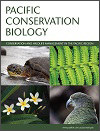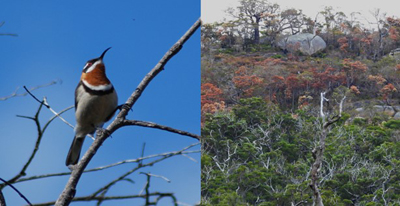Pacific Conservation Biology
Volume 30
Number 6 2024
The terrain and soils of the Two Peoples Bay Nature Reserve are complex and variable. They have formed through weathering of geological materials within the Reserve, transportation of dune sands by the wind, and deposition of lake sediments. These historical processes explain the pattern of soils and landscape features that are observed in the present day.
This article belongs to the collection: The Natural History of Two Peoples Bay Nature Reserve, Western Australia.
The extensive Townsville-Burdekin freshwater wetlands support important waterbird assemblages. Despite many effects of agricultural development (e.g. changes in hydrological processes, vegetation and water quality), assemblages have apparently changed very little over the last four decades. Nevertheless, the wetland complex requires active, holistic management for conservation of the waterbirds and other biota.
Pelagic thresher sharks are of conservation priority due to their globally endangered status. This research provides information and recommendations for data-poor fisheries in Indonesia. The results show that fishers use bottom longlines to target sharks in the eastern Indian Ocean. We offer potential management measures to reduce mortality on pelagic threshers by applying a mitigation hierarchy framework.
A long-term dataset was used to examine the impact of declining rainfall and increasing temperature on Carnaby’s Cockatoo (Zanda latirostris) with results showing that survival of Carnaby’s Cockatoos will be impacted by changes in rainfall, and by an increase in the number of days with maxima ≥35°C, conditions when the birds are unable to forage leading to a further contraction in the range of Carnaby’s Cockatoo.
Community-based conservation groups face a variety of challenges that lead to limited success. Therefore, it is important to understand the barriers to volunteering, aspects that limit effectiveness, and ways to assess and improve effectiveness. Social interaction was the top way to recruit volunteers the main barriers to participation were time commitment and health issues. Relationships between volunteers, and stakeholders also impacted their success, and environmental monitoring was key to obtaining funding and documenting success.
Two Peoples Bay Nature Reserve is a significant refuge for threatened species including noisy scrub-bird and Gilbert’s potoroo. This article describes the first 30 years of management of the Reserve, from its declaration in 1967 up to 1999. Major management concerns have included fire, commercial activities and visitors.
This article belongs to the collection: The Natural History of Two Peoples Bay Nature Reserve, Western Australia.
Knowing the locations of species’ critical habitats from adult aggregation sites to parturition sites and nursery areas is important for implementing effective conservation measures. Here, we show that Fiji’s rivers are critical for the completion of the bull shark’s life cycle. Fiji’s authorities are encouraged to implement regulatory safeguards to preserve and protect the Fijian bull shark population’s critical habitats.
For over a billion years, gneisses and granites in Two Peoples Bay Nature Reserve, Western Australia, sat at the heart of east Gondwana. The Cenozoic landforms and surficial deposits reflect medium- to long-term climate change, and sea level rises and falls, as the Australian Plate moves north to collide with south-east Asia.
This article belongs to the collection: The Natural History of Two Peoples Bay Nature Reserve, Western Australia.
Carnaby’s Cockatoo (Zanda latirostris) is an endangered species endemic to south-western Australia. This paper examines the maximum recorded life of the species in the wild compared with longevity records of long-lived birds recorded on the banding register of Australia, USA, and UK. Carnaby’s Cockatoos were recorded living up to 35 years, putting the species in the top 2% of all bird species in the wild.
We reviewed 371 media articles on the bushfires and koalas in New South Wales published between September 2019 and October 2020 for a qualitative analysis of impacts, factual errors and misinformation, themes and imagery. Presentation of exaggerated figures obscured the complexity of the issues. We concluded that to put numbers on koalas killed and the New South Wales koala population can be misleading as it erodes public trust in media and distorts scientific facts.
Conducting research in large offshore areas usually require large research vessels, significant funding and specific expertise, most of which are not readily available in small island developing states. Even with limited funding, facilities and expertise, we were able to answer a key research question for the fully offshore Palau National Marine Sanctuary. Furthermore, by doing so developed a research platform with five key steps to develop and implement offshore research with limited resources and expertise.
This is the first detailed study on the Ravensthorpe Range slider (Lerista viduata), one of Australia’s rarest reptiles. The species has long had a Data Deficient conservation status; however, our investigations reveal that, alarmingly, it is actually Critically Endangered (i.e. the most severe status before Extinct in the Wild). As such, we reveal that L. viduata should be amongst the highest of Australia’s conservation priorities.
The beach and coastal dune systems of Two Peoples Bay Nature Reserve are mapped and the terrain features comprising the beach and dune systems are described. The evolutionary patterns of the major dune forms are elucidated for this little-known area.
This article belongs to the collection: The Natural History of Two Peoples Bay Nature Reserve, Western Australia.
This paper provides an updated forage list for the endangered Carnaby’s cockatoo (Zanda latirostris). Proponents seeking land clearing approval that may impact Carnaby’s cockatoos must provide detailed habitat assessment, however, the current forage species list is outdated. This updated list will inform proponents and regulators, aiding the referral process and the potential protection and conservation of important and diminishing habitat resources.
Through local ecological knowledge and field surveys, we discovered an undocumented Reeves’s butterfly lizard (Leiolepis reevesii) population on Qi’ao Island of China, which is the first record in the Pearl River Delta since the early 2010s and represents the only remaining population from the vicinity of its type locality. However, it is reported to be very rare on the island now, urgent conservation action and education campaigns are required to prevent further declines.
The grey-headed flying-fox (Pteropus poliocephalus) is a vulnerable species susceptible to numerous factors known to produce simultaneous deaths. We present observations of two incidents involving trees collapsing and killing multiple flying-foxes that were roosting in those trees.
A study of adult and fledgling Carnaby’s cockatoo movements from 11 breeding sites during the non-breeding season showed that sub-adult cockatoos roam much more widely than adults, foraging in habitat an order of magnitude more remote from breeding sites than previously reported. More distant habitat now needs to be considered important in supporting populations.
Coconut (or robber) crabs (Birgus latro) are the largest terrestrial arthropod. We provide the first detailed report of their occurrence on the islands of Oeno, Henderson, and Ducie Atoll in the Pitcairn Islands, extending their known range by more than 600 km.
Urban areas are expanding rapidly, leading to habitat and biodiversity loss. However, they may offer resources during environmental stressors like drought. Our study in south-west Western Australia found dramatic increases in reporting rates for four bird species during a climate anomaly, highlighting their adaptive behavioural responses and the potential of urban areas as refuges. Photograph by Harry Moore.
Data Deficient species can be neglected in conservation management. We used a targeted field survey, ecological study, and species distribution modelling to determine the conservation status of the Eungella shadeskink. It is confined to areas near water and has a severely restricted Area of Occupancy and Extent of Occurrence. The main threats are fire, invasive alien species and climate change. The species is forecast to lose all climatically suitable habitat by 2080, and meets criteria for Critically Endangered listing.
We investigated the archipelago-wide status of Micronesian Megapodes (Megapodius laperouse) in the Mariana Islands. Findings indicate that megapode population and distribution in the Mariana Islands are limited by availability of native forest and human presence. We discuss studies of breeding and movement patterns, and removal of introduced ungulates and predators to benefit the species.
Many Australian native bees visit native flora, sometimes exclusively. Corymbia calophylla (Marri) is endemic to the southwest Western Australian biodiversity hotspot. We reveal this flowering tree is visited by 81 species of native bees. This is an incredible diversity, emphasising the value of this plant for native bee conservation.
What is happening with sea otters in remote unpopulated areas? This question arose during recent expeditions to the Kuril Islands. Sections of shore have been surveyed, revealing a decline in sea otter populations. It is likely that this decline is due to illegal hunting, similar to occurrences in the remote past.
An obituary for Peter Spencer, who passed away in 2024.






